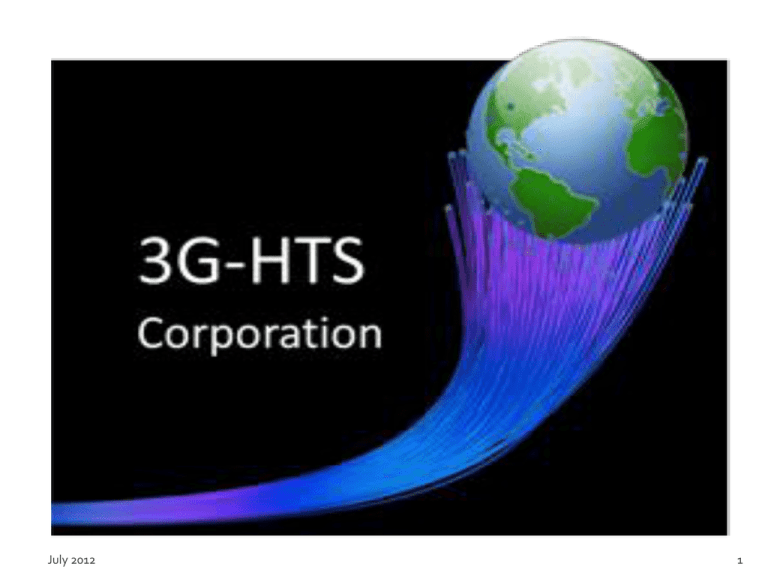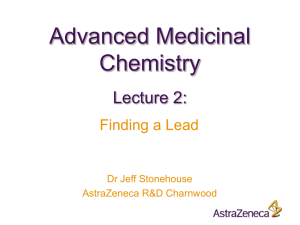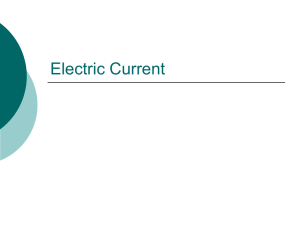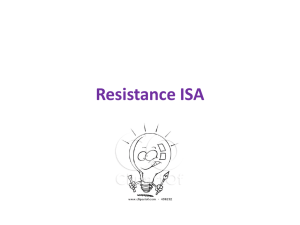Presentation - 3G-HTS
advertisement

July 2012 1 • Founded in 2011 to commercialize a new nanotechnology and superconductor products resulting from a decade of self funded laboratory research by Dr. Anatoly Rokhvarger. Unique , Patented, Cost-effective and Commercially Viable Ceramic Processing to produce composite high temperature superconductor (HTS) macro-ceramic leads and cost effective electric round wire round wire. • Goal: sublicense and/or manufacture the major electrical engineering material; the next (Third) Generation High Temperature Superconductor electric wire and related products (3G-HTS). • By replacing traditional electric copper wire with inexpensive 3G superconducting multi-filament (round) wire, industries realize a 5 – 10x decrease in cost, weight, size/diameter, and power heat losses of electrical cables, motors, transformers and generator rotors saving up to 20% power consumption, yet can transmit power at room temperature like copper. • Multi-billion dollar world market potential – Broad applications in power transmission systems and cables, data centers, energy storage, Internet and telecommunications networks, electrical equipment, super-computers, defense, marine, aviation/transportation, MRI and other medical apps July 2012 2 3G HTS electric wire innovation consists of six interrelated patented inventions; 1) the initial material formulation consisting of YBCO ceramic powder, silver powder dope and a silicone polymer multi-purpose additive; 2) a method of deep adhesion coating of continuous metal substrate round filament with HTS ceramic powder suspension; 3) a method of uniform magnetic orientation of YBCO grains within green coating layer; 4) a method for the chemical-ceramic engineering processing resulting in fullydense sintered HTS macro-ceramic leads; 5) a new product - HTS ceramic coated continuous round filaments that we named 3G HTS electric wire; and 6) the fully mechanized conveyor manufacturing method using inexpensive equipment for “substrate-filament-reel” – to – “3G HTS-wire-reel” production. July 2012 3 Adhesion coating layer Metal core substrate filament A photo picture of the flexible 3G HTS filament made at our laboratory where a part of the ceramic coating layer was intentionally removed to show the YBCO ceramic coating layer of 10 µm thickness on the metal substrate July 2012 4 As opposed to 2G HTS tape, 3G HTS filaments are as reliable and workable as ordinary copper wire filaments and they: • high magnetic sustainability to be efficiently used in coils of electric motors, transformers and generator rotors ; • can be woven into multi-filament electric wire or cable of any diameter for any high level current carrying capacity capacity; •easy spliced with each other; do not need silver sheath; • 8-9 micron thickness of the HTS ceramic coating layer makes 3G HTS filaments quench effect resistant • do not chemically degrade (are permanently resistant) during storage and service in air or liquid nitrogen environment. July 2012 •3G HTS wire and cable at liquid nitrogen temperature can transmit electric current density 15-20kA/cm2, which is the most beneficial range for HTS cables and HTS wire applications; • The Cost : Performance ratio (C/P, $/kA – meter) of 3G HTS wire C/P=$79/kA-m while copper has a C/P= $2050/kA-m. C/P of 3G-HTS is at the threshold of $10/kA-m being defined by the US DOE as the ability of HTS wire to compete with copper electric wire; • The technologically available minimum diameter of the elementary 3G HTSYBCO filament is 60 microns or 0.06mm. This 3G HTS filament can transmit electricity comparable to copper wire with a diameter of 6 millimeters but with 3-5 times decreasing heat losses. 5 July 2012 6 Our patents provide protection for lowest cost techniques & better HTS electric leads : “Sintered Ceramic Composite Lead with Superconductive NanoArchitecture”, US Patent # 7,632,784, “Superconductor Composite Material”, US Patent # 6,617,284, ”High Temperature Superconductor Composite Material”, US Patent # 6,239,079, “Method of Conveyor Production of High Temperature Superconductor Wire, and Other Bulk-Shaped Products Using Compositions of HTS Ceramics, Silver, and Silicone”, US Patent # 6,010,983 Intellectual Property July 2012 7 • Dr. Anatoly Rokhvarger – Senior Vice President & Chief Technology Officer D.Sc. - in Ceramic Engineering and Materials Science, Tech. Un., Leningrad, f. USSR Ph.D. - in Ceramic Engineering and Materials Science, Chem.-Tech. Univ., Moscow MS - in Chemical and Ceramic Engineering, Chem.-Tech. Univ., Moscow, MS - in Applied Statistics, Design of Experiment and System Analysis, Moscow State University. • Lyubov Chigirinskaya – Vice President - Research Ph.D. in Chemistry Institute of Physical Chemistry of the USSR Academy of Science, Moscow M.S. in Chemical Resistance of Materials – Metals, alloys, Polymer, The Inst. of Physical Chemistry, Moscow, B.S. in Metallurgy -Institute of steel and alloys, Department of Physical Chemistry, Moscow • Norman Kaish, CEO An innovative corporate startup developer and technology entrepreneur with over 30 years experience specializing in the launch and development of industrial and technology based companies. Mr. Kaish holds a BS in Business from Pace University and US and International patents in electronic, electro-mechanical and electro-chemical technologies . He also has extensive experience in patent and trademark filings and prosecution. • Arthur Goldberg – Chief Financial Officer Mr. Goldberg earned his B.B.A. from the City College of New York, his M.B.A. from the University of Chicago and his J.D. and LL.M. from the New York University School of Law. Mr. Goldberg is also a Certified Public Accountant July 2012 8 July 2012 9 Dr. Anatolii Polyanskii , Director of Magneto-Optical laboratory, Applied Superconductivity Center (ASC), The National High Magnetic Field Laboratory Applied Superconductivity Center. Dr. Miriam Rafailovich, Chief Scientist Advanced Energy Research & Technology Center (AERTC) Professor of Materials Science & Engineering Program in Chemical Engineering at the State University of New York at Stony Brook Dr. Inna Talmy, Distinguished Ceramic Scientist Naval Surface Warfare Center (NSWC), 27 year career in superconductor and ceramic weapons applications Mr. Michael Parizh, Electromagnetic Platform Leader, General Electric - Global Research. Formally Senior Manager at Philips Healthcare for almost 20 years. Mr. Mark Senti, President, Advanced Magnet Lab , Contracts with NASA and DOE in designing, optimizing, manufacturing and testing electromagnetic systems Dr. Eugene Medvedovski, Ph.D. in Ceramic Engineering Scientific and Project Engineering Institute of Cable Industry, Moscow, Russia. 25+ experience in development and production of ceramic materials and products for power transmission and other advanced applications Dr. Sergey Drabkin, President Consela Engineering, Professional Engineer licensed in New York, New Jersey Connecticut and Pennsylvania July 2012 10 Estimation of the wholesale market price of 3G HTS electric wire of one meter in length, diameter 0.06mm, and conservative cost $0.30, which can transmit electricity as copper wire with diameter 6mm and cost of one meter $10.00 - $20.00 COPPER 2G HTS 3G HTS Current Carrying Capacity JE , kA/cm2 0.2 - 0.4 8 - 12 15-20 Cost : Performance Ratio, C/P, $/kA-m 15 - 50* 75 - 90 7-9 10-20* 450 – 600 110 4.8 – 24** Unavailable 50 0.05 – 0.24* Unavailable 0.5 (0.27)*** Cost of Wire 1 m x d= 1cm, $ Cost of Wire 1m x d= 0.6cm **, $ Cost of one Elementary Filament (strand), - 1 meter x d = 0.006cm, $ Estimated selling price of 1 meter of 3G HTS electric round wire, d = 0.06mm, $ 10.00 -20.00 * = wholesale market price; ** = wholesale price of #2 AWG stranded (1/4 inch) wire; *** = initial YBCO and silver powder additive cost July 2012 11 Major Engineering Advantages Multi-filament 3G HTS wire is flexible, reliable, and workable as ordinary copper wire but at liquid nitrogen temperature transmits with insignificant heat losses 50 – 100 times more power than ordinary copper wire does at room temperature. The 3G HTS-YBCO filaments can be woven into multi-filament electric wire or a cable of any diameter and capacity carrying electric current as 10 – 20kA/cm2, which is the most beneficial range for HTS cables. Most inexpensive and Efficient HTS ceramic forming and sintering methods July 2012 3G HTS round filaments working at liquid nitrogen t-re: • have high magnetic sustainability to be used in coils of electric motors, transformers, generator rotors, and jet propulsion engines; • can transmit electricity with 3 - 5 times less heat losses than copper wire 3G HTS wire at room temperature can transmit power as ordinary copper wire and multiple magnitudes more power at 77k. 12 Industrial cost forecast An industrial plant will be composed by typical conveyor lines for “substrate filament reel” – to – “3G HTS filament reel” production; - Each line should cost about $800,000 and annually produce 500km 3G HTS wire; - 3G HTS electric wire (filament) has diameter 0.06 millimeter and transmits electricity as copper wire with diameter 6 millimeter; The production cost of one meter of 3G HTS wire (filament) of 0.06 millimeter diameter is estimated as $0.30; - The wholesale price of one meter 3G HTS wire (filament) of diameter 0.06 millimeter is estimated as $10-$20 in full production. - 3G HTS wires (filaments) can be twisted (woven) into multi-filament electric cable. July 2012 13 YBCO ceramic particles, Silver nano-powder, Silicone polymer, Toluene solvent, and Continuous NiCr filament substrate ↓ 1. Materials preparation consisting of mechanical mixing and ultrasonic homogenization of YBCO and silver-dope powders suspension in silicone-toluene solution ↓ 2. Forming HTS filaments using adhesive dip coating the core filament substrate by solid particle suspension ↓ 3. Uniform magnetic orientation of YBCO grains within green coating layer ↓ 4. Polymerization in tunnel oven of silicone resin with embedded YBCO grains ↓ 5. Ceramic firing consisting of multiple steps including; organic burnt out, heating, liquid-phase sintering, cooling, oxygenation, and final cooling; all in a tube/tunnel electrical furnace with programmable multi-step controller and oxygen flow in opposite direction of continuous movement of 3G HTS filaments ↓ 6. Finishing - twisting HTS-YBCO filaments into multi-filament electric wire w/ further coating 3G HTS wire by silicone polymer resin and thermal polymerization of insulation sheath July 2012 14 A cost-effective thermo-chemical (Ceramic Engineering) method for nanofabrication of the formed and sintered (backed) macro-size ceramic leads from initial high temperature superconducting (HTS) ceramic particles making equal inter-grain superconductivity of 3G HTS ceramic macro-leads to inner-grain nano-scale superconductivity of the initial HTS ceramic particles and their crystal grains. Thermo-chemical method of multi-step firing of YBCO coated filament in vertical tube furnace, which results in unique superconductive nano-architecture of full dense sintered YBCO macro-ceramics coating NiCr substrate filament; Dip adhesion coating of 3G HTS filament by silicone insulator; “Substrate filament reel” – to – “3G HTS filament reel” conveyor processing using original filament handling conveyor system; Scrap free thermo-chemically self-controlled manufacturing process; The application of inexpensive and market available equipment components. July 2012 Raw Material Composition comprising any superconducting ceramic (YBCO) powder), silver powder dope, and unique organic/inorganic silicone polymer additive; Ultrasonic particle dispersing and homogenization of the raw materials suspension; Chemically self-controlled dip adhesion coating of the metal substrate by ceramic-silver powder suspension; Uniform orientation of ceramic grains within coating layer of the filament moving between magnet poles; Polymerization hardening of the ceramicpolymer composite in vertical tube oven; 15 Major Engineering Advantages 3GHTS wire is well competitive with traditional copper wire • 3G HTS wire at LN t-re can transmit with insignificant heat losses electric current density, JE = 12– 15kA/cm2 while electric copper wire can transmit JE = 0.2 – 0.4kA/cm2. This makes 3G HTS wire very efficient for HTS cables and other electric engineering applications; • The Cost : Performance ratio (C/P, $/kA – meter) of 3G HTS wire is C/P=$7 – $9/kA-m, while copper wire has C/P=$20 – $50/kA-m. C/P ratio of 3G HTS wire is at the threshold of $10/kA-m being defined by the US DOE for the ability for HTS wire to compete with traditional copper electric wire; • The technologically available minimum diameter of the elementary 3G HTSYBCO filament is 60 microns or 0.06mm. This 3G HTS wire can transmit electricity as copper wire with diameter 6 millimeters but 3 – 5x decreasing heat losses. July 2012 16 Pictures of 3G HTS lead prototypes a b c a, Four 3G HTS-YBCO filaments; b, Slip cast formed and sintered HTS-YBCO plate, 20 x 20 mm; c, The rare-earth magnet (0.225g, 5mm in diameter) levitating in air, 7mm above a dry-pressed and sintered HTSYBCO tablet of 30mm in diameter immersed in liquid nitrogen coolant. July 2012 17 Resistivity, Ohm∙cm and heat power dissipation, Watt/cm for a) 3G HTS ceramic coated silver substrate strand (green) and b) silver strand (red), both at 77K and c) silver strand at 300K (blue) VS. current density (logarithmic scales) July 2012 18 Volt - Ampere characteristics of metal and HTS strands; each metal strand and HTS strand silver substrate diameter ~ 0.127mm 0.05 0.045 0.04 Voltage, V/cm 0.035 0.03 0.025 HTS-15-2001, LN 0.02 HTS-15-2004, LN 0.015 HTS-S 2004, LN Copper, Room T 0.01 Silver, Room T 0.005 0 0.0E+00 July 2012 3.0E+03 6.0E+03 9.0E+03 1.2E+04 Current density, A/cm2 1.5E+04 1.8E+04 19 Engineering characteristics of 1G or OPIT (oxide ceramic powder loaded in silver tube), 2G or TFD (ceramic film deposition on multi-metal template tape), and 3G ceramic coated / sintered filaments (metal substrate filaments coated with sintered ceramics) HTS wires. 1 Substrate and/or cover material silver multi-layer metals NiCr alloy 2 Geometrical form of wire element tube tape filament 3 Wire forming method rolling/drawing template deposition adhesion coating 4 Thickness of the workable HTS ceramic layer, µm 5 – 20 0.2 – 0.3 6–8 5 Magnetic susceptibility low low high 6 Cross-section ratio for ‘substrate & cover’ : ‘HTS ceramics’ (2 – 3) : 1 (500 – 1000) : 1 1:1 7 Ratio of production costs to raw material costs (2 – 3) : 1 (5 – 8) : 1 1.1 : 1 8 Capital costs of manufacturing in comparison with each other 5–7 7 – 12 1 9 Eng. electric current density of the HTS wire, kA/cm2 1–2 8 – 12 10 Cost/performance ratio of wire (C/P) $/kA-m 200 - 300 75 - 90 7–9 11 Insulation of HTS wire silver tube silver cover tape silicone resin 12 Comparison of AC current losses of electric wires 1 (round) 5 (tape) 1 (round) 13 Scrap during prototype wire production significant significant insignificant 14 Estimation of flexibility as max. wire bent, grads 30 - 50 40 - 60 140 - 150 15 Achievable Cost/Performance ratio of wire (C/P), $/kA-m 200 – 300 75 – 100 4–6 16 Quench effects 17 Superconductivity degradation after 3-5 year long service 18 Complicity of ceramic grain alignment and orientation 19 Possibility to splice two wire pieces 20 End-use applications in electric motors and transformers 21 Electro-magnetic shielding of HTS wire significant 22 Conductivity of HTS wire at room temperature, as Long length variability of wire thickness/diameter and 23 superconductivity April 2012 July 2012 remarkable significant 25 – 30 self-compensated remarkable no degradation incomplete complete complete difficult difficult easy to do ineffective difficult effective self-shielded difficult self-shielded as silver metal as copper metal as silver metal significant significant no variations 20 3GHTS.COM Third Generation High Temperature Superconductor Contact: Norm Kaish nk@3ghts.com 516-993-9727 July 2012 21








